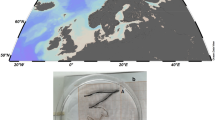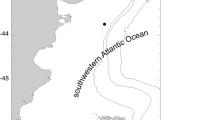Abstract
Reproduction and development of the ophiuroidOphionereis olivacea H. L. Clark, a species that broods its young, were investigated in Florida from January through December 1985 and in Belize in June 1985 and April 1986.O. olivacea has a maximum disc diameter of 5.2 mm and is a protandric hermaphrodite. Sex reversal occurs at disc diameters ranging between 2.2 and 4.0 mm; it has 400 µm diameter oocytes and is ovoviviparous. As expected from an obligate out-crosser, this ophiuroid has a similar allocation to male and female reproduction, in terms of gonad volume. Reproduction of the Florida population was monitored for one year.O. olivacea is a sequential brooder and incubates its young during the coldest months of the year. The females produce a single clutch of juveniles each year. Spawning starts in November and peaks in January and February. The ova are spawned synchronously from all the ovaries of each female into the bursae and are retained there. Fertilization is accomplished by intake of sperm into the female bursae.O. olivacea develops through a ciliated embryonic stage that appears to be a modified vitellaria larva lacking ciliary bands. These modified larvae swim in seawater in the bursae. Direct development in this species has resulted from heterochrony in the loss of ophiopluteus features. The number of brooding females in the population increases in November and reaches a maximum in March. JuvenileO. olivacea emerge from the bursae at a disc diameter of 480 µm and each arm has three segments. Recruitment was first detected in April, and juveniles were particularly abundant in June. Small size inO. olivacea is associated with paedomorphic heterochrony with precocious maturation of the males at a disc diameter of 1.5 mm, ~2 mo after taking up their free existence. Brooding as a life history mode inO. olivacea is examined and the adaptations of this species to its warm-water habitats are discussed.
Similar content being viewed by others
Literature cited
Aronson, R. B. (1987). Predation on fossil and recent ophiuroids. Paleobiology 13: 187–192
Byrne, M. (1988). Evidence for endocytotic incorporation of nutrients from the haemal sinus by the oocytes of the brittlestarOphiolepis paucispina. In: Burke, R. D., Lambert, P. V., Parsley, R. L. (eds.) Echinoderm biology. Balkema, Rotterdam, p. 557–562
Byrne, M. (1989). Ultrastructure of the ovary and oogenesis in the ovoviviparous ophiuroidOphiolepis paucispina (Echinodermata). Biol. Bull. mar. biol. Lab., Woods Hole 176: 79–95
Byrne, M. (1991). Life history traits of Caribbean ophiuroids that brood their young. In: Suzuki, N. (ed.) Proceedings of the Sixth International Echinoderm Conference. Balkema, Rotterdam, in press
Charnov, E. L. (1982). The theory of sex allocation. Princeton University Press, New Jersey
Chia, F. S. (1970). Reproduction of artic marine invertebrates. Mar. Pollut. Bull. 1: 78–79
Chia, F. S. (1974). Classification and adaptive significance of developmental patterns in marine invertebates. Thalassia jugosl. 10: 121–130
Eernisse, D. J. (1988). Reproductive patterns in six species ofLepidochitona (Mollusca: Polyplacophora) from the Pacific Coast of North America. Biol. Bull. mar. biol. Lab., Woods Hole 174: 287–302
Emlet, R. B., McEdward, L, R., Strathmann, R. R. (1987). Echinoderm larval ecology viewed from the egg. In: Jangoux, M., Lawrence, J. M. (eds.) Echinoderm studies. Balkema, Rotterdam, p. 55–136
Emson, R. H., Mladenov, P. V., Wilkie, I. C. (1985). Patterns of reproduction in small Jamaican brittle stars: fission and brooding predominate. In: Reaka, M. L. (ed.) The ecology of coral reefs. NOAA Symp. Ser. Undersea Res. 3: 87–100
Fell, H. B. (1946). The embryology of the viviparous ophiuroidAmphipholis squamata Delle Chiaje. Trans. R. Soc. N.Z. 75: 419–464
Fontaine, A. R., Chia, F. S. (1968). Echinoderms: an autoradiographic study of assimilation of dissolved organic molecules. Science, N.Y. 161: 1153–1155
Heath, D. J. (1977). Simultaneous hermaphroditism; cost and benefit. J. theor. Biol. 64: 363–373
Heath, D. J. (1979). Brooding and the evolution of hermaphroditism. J. theor. Biol. 81: 151–155
Hendler, G. (1975). Adaptive significance of the patterns of ophiuroid development. Am. Zool. 15: 691–715
Hendler, G. (1979). Sex-reversal and viviparity inOphiolepis kieri, n. sp. with notes on viviparous brittlestars from the Caribbean (Echinodermata: Ophiuroidea). Proc. biol. Soc. Wash. 92: 783–795
Hendler, G. (1982). An echinoderm vitellaria with a bilateral larval skeleton: evidence for the evolution of ophiuroid vitellariae from ophioplutei. Biol. Bull. mar. biol. Lab., Woods Hole 163: 431–437
Hendler, G. (1988). Ophiuroid skeleton ontogeny reveals homologies among skeletal plates of adults: a study ofAmphiura filiformis, Amphiura stimpsonii andOphiophragmus filograneus (Echinodermata). Biol. Bull. mar. biol. Lab., Woods Hole 174: 20–29
Hendler, G. (1991). Ophiuroidea. In: Giese, A. C., Pearse, J. S., Pearse, V. B. (eds.) Reproduction of marine invertebrates. Vol. 9, Blackwell Scientific, Palo Alto (in press)
Hendler, G., Littman, B. S. (1986). The ploys of sex: relationships among the mode of reproduction, body size and habits of coral reef brittlestars. Coral Reefs 5: 31–42
Hendler, G., Peck, R. W. (1988). Ophiuroids off the deep end: fauna of the Belizean fore-reef slope. In: Burke, R. D., Lambert, P. V., Parsley, R. L. (eds.) Echinoderm biology. Balkema, Rotterdam, p. 411–419
Hendler, G., Turner, R. L. (1987). Two new species ofOphiolepis (Echinodermata): Ophiuroidea) from the Caribbean Sea and Gulf of Mexico: with notes on ecology, reproduction, and morphology. Contr. Sci. 395: 1–14
Highsmith, R. C. (1985). Floating and algal rafting as potential dispersal mechanisms in brooding invertebrates. Mar. Ecol. Prog. Ser. 25: 169–179
Kabat, A. R. (1985). The allometry of brooding inTransennella tantilla (Gould) (Mollusca: Bivalvia). J. exp. mar. Biol. Ecol. 91: 271–279
Littler, M. M., Taylor, P. R., Littler, D. S. (1983). Algal resistance to herbivory on a Caribbean barrier reef. Coral Reefs 2: 111–118
McGrath, D., ÓFoighil, D. (1986). Population dynamics and reproduction of hermaphroditisLasaea rubra (Montagu) (Bivalvia, Galeommatacea). Ophelia 25: 209–219
Mileikovsky, S. A. (1971). Types of larval development in marine bottom invertebrates, their distribution and ecological significance: a re-evaluation. Mar. Biol. 10: 193–213
Mladenov, P. V. (1985). Development and metamorphosis of the brittle starOphiocoma pumila: evolutionary and ecological implications. Biol. Bull. mar. biol. Lab., Woods Hole 168: 285–295
Mortensen, T. (1920). On hermaphroditism in viviparous ophiuroids. Acta Zool., Stock. 1920: 1–18
Mortensen, T. (1921). Studies on the development and larval forms of echinoderms. G.E.C. Gad., Copenhagen
Mortensen, T. (1933). Papers form Dr. Th. Mortensen's Pacific Expedition 1914–16. LXIII. Biological observations on ophiurids, with descriptions of two new genera and four new species. Vidensk. Meddr dansk. naturh. Foren. 93: 171–194
Mortensen, T. (1936). Echinoidea and Ophiuroidea. ‘Discovery’ Rep. 12: 199–348
Paul, V. J., Fenical, W. (1983). Isolation of Halimedatrial: chemical defense adaptation in the calcareous reef-building algaHalimeda. Science, N.Y. 221: 747–749
Sides, E. M. (1987). An experimental study of the use of arm regeneration on estimating rates of sublethal injury on brittle-stars. J. exp. mar. Biol. Ecol. 106: 1–16
Strathmann, R. R. (1978). The evolution and loss of feeding larval stages of marine invertebrates. Evolution 32: 894–906
Strathmann, R. R., Chafee, C. (1984). Constraints on egg masses. II. Effects of spacing size, and number of eggs on ventilation of masses of embryos in jelly, adherent groups, or thin-walled capsules. J. exp. mar. Biol. Ecol. 84: 85–93
Strathmann, R. R., Strathmann, M. F. (1982). The relationship between adult size and brooding in marine invertebrates. Am. Nat. 119: 91–101
Strathmann, R. R., Strathmann, M. F., Emson, R. H. (1984). Does limited brood capacity link adult size, brooding, and simultaneous hermaphroditism? A test with the starfishAsterina phylactica. Am. Nat. 123: 796–818
Thorson, G. (1950). Reproductive and larval ecology of marine bottom invertebrates. Biol. Rev. 25: 1–45
Vance, R. R. (1973). On reproductive strategies in marine benthic invertebrates. Am. Nat. 107: 339–352
Walker, C. W., Lesser, M. P. (1989). Nutrition and development of brooded embryos in the brittlestarAmphipholis squamata: do endosymbiotic bacteria play a role? Mar. Biol. 103: 519–530
Author information
Authors and Affiliations
Additional information
Communicated by G.F. Humphrey, Sydney
Rights and permissions
About this article
Cite this article
Byrne, M. Reproduction, development and population biology of the Caribbean ophiuroidOphionereis olivacea, a protandric hermaphrodite that broods its young. Mar. Biol. 111, 387–399 (1991). https://doi.org/10.1007/BF01319411
Accepted:
Issue Date:
DOI: https://doi.org/10.1007/BF01319411




